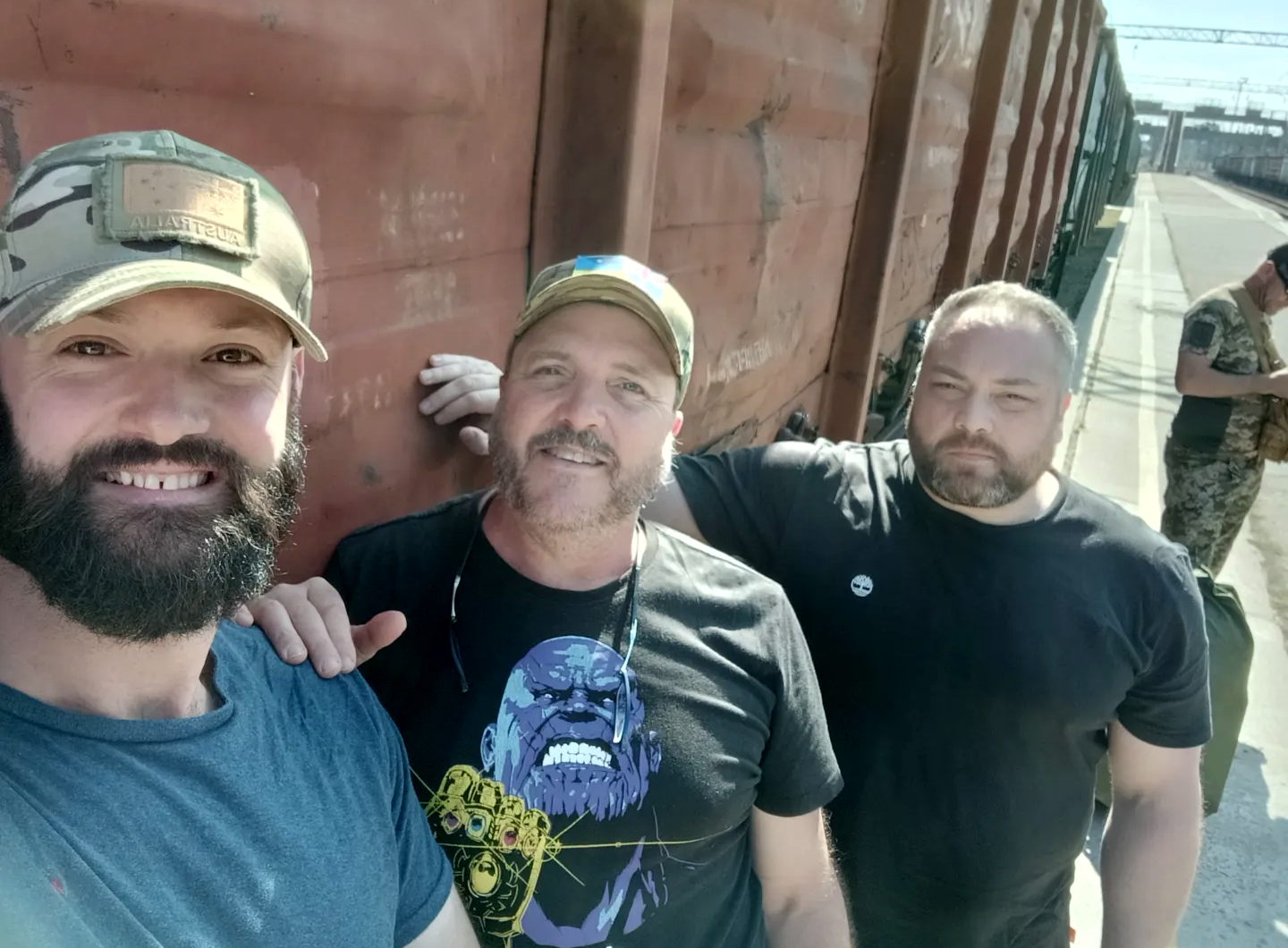
'Where you're going is well within small arms range of the Russians, hundreds of metres at points.'
On the frontlines in the war-torn Donbas region of eastern Ukraine, the first target of Russian attacks are tanks and the second are medics.
“If you can destroy their chain of evacuation, it means that more soldiers die in the battle,” said Ambulance Tasmania paramedic Matt Pickering, who alongside fellow AT paramedics David Brown and Daniel Tree each spent between four and six weeks less than two kilometres from the Russian front.
The three operated in an unmarked ex-Amsterdam ambulance, one of many donated to the war effort by countries throughout Europe. It was rudimentary vehicle, equipped with just a spare tyre, a backpack and a stretcher. Pockmarked with bullet holes in its windows and chassis, the vehicle bore witness to the ever-present danger facing medical personnel operating in an unrelenting war zone.
When not being used, the ambulance was fully camouflaged and hidden under trees. With the exception of a small red cross in the vehicle, when being driven it was devoid of the large, universally recognisable red crosses and flags that typically offer medics a degree of protection against attack.
It was a world away from their lives in Tasmania, and a baptism of fire in what has become a protracted and brutal two-year military campaign since Russia’s invasion of Ukraine in 2022, thus far claiming an estimated 100,000 Ukrainian soldiers’ lives and more than 20,000 civilian deaths and casualties.
Each had a similar motivation for heading to Ukraine – a burning desire to help the war effort and to use their professional skills and capacities in a different and more challenging environment. All three had initially begun their journey individually, but word of mouth among paramedics soon brought them together.
“It just so happened that all three of us were going to be there around the same time. We found out about each other's plans through the grapevine at work. Dan had already headed over. Dave and I had been in touch for a while and worked out our plans, so we decided to dial in the dates and go there together,” Matt said. “Right up until literally the week of leaving, as far as I was concerned I was going on my own.”
The trio all went via the Road to Relief NGO, a Ukrainian-registered humanitarian NGO established in March 2022 with the purpose of helping civilian populations most affected by the Russian invasion. Its work has since expanded to include casualty and medical evacuations and emergency treatment of injured soldiers in coordination with the Armed Forces of Ukraine.
David said the first 24 hours in the capital, Kyiv, were “discombobulating” amid the sounds of sirens signalling incoming missiles.
“I remember feeling that sort of tightness in the belly,” he said. “It was the first and only time I went to a bomb shelter. I looked in a few, but I didn't actually go and seek any kind of refuge. There were only a couple of people in there; the rest were still going about their business. It was really strange - this is a country at war and I was expecting bombs to fall all the time. It was quite discombobulating, not stressful, just really uncertain what the rules were in this place. It's amazing how quickly you get used to it within 24 hours. It was almost like I'd been there a month.”
“And then we're sitting in a cafe while the alarms go off and we just continue with our lunch and there'd be artillery landing nearby. In the first few days you'd be like, ‘oh’; a week in, you hear them and you're like, ‘oh yeah, that's a bit close’. You lose any fear. It just becomes completely normal.”
As they moved closer to the frontlines, the same pattern of initial uneasiness followed by rapid adaptability became the norm. It’s a psychological behaviour known as “risk creep” in which people progressively push their boundaries.
“This concept was relayed to us about war zones where you move a bit closer and it feels fine,” Matt said. “So we're apprehensive about crossing the border into Ukraine. We get to Kyiv, there's an alert, nothing happens, and you're like, ‘ok, this is fine’. So within a day you're switching your alerts app off and going with the flow. And then you move to Donbas and you're like, ‘oh, this is a starting to feel a bit real’, and then nothing happens and you and go, ‘ok’.
“So you move up towards the frontline and you hear artillery and things blowing up next to you but you don't get hurt. And you're like, ‘this is fine’. It's the creep - you move closer and closer until, which is what unfortunately happened with our NGO guys, the creep caught up with them in the end because they found that point at which reality occurs and you’ve crept a little bit too far.”
Road to Relief Director Emma Igual and her colleague Anthony “Tonko” Ihnat were killed last September when the vehicle they were driving towards Bakhmut came under artillery fire. Two others travelling with them suffered serious shrapnel injuries.
Daniel said that prior to arriving in the Donbas, he expected to operate in much the same manner as in Australia in terms of emergency response, but with limited equipment, a landscape littered with land mines, horrific injuries, and constant close proximity to Russian troops, the situation on the ground proved vastly different.
“The expectation of working in a functioning ambulance was very naive of us,” he said. “We rolled up and the vehicle that we were going to work in was damaged and so we were relegated to basically a postal van with a stretcher and a backpack in it. It put us into a different mindset.”
And while Ukrainian soldiers had rudimentary knowledge of Tactical Casualty Combat Care that enabled them to administer basic first aid, many had to endure long waits for retrieval.
“A lot of these patients are heavily shocked because they've been sitting at the zero line waiting for extraction for sometimes eight or nine hours,” Daniel said. “We'd get a radio call saying we've got five casualties coming in. By the time they organised a vehicle so that we can get our hands on them, there might be 20 casualties, and they've been lying there losing blood for many hours. Some have had tourniquets on for hours.
"Dave did a lot of the clinic work, which by and large was much more dangerous than the medivac work that we were doing although they all come with risks. When you're doing the medical clinics, you're going in blind, and there were times where we had to sit down and have conversations and say, where you're going is well within small arms range of the Russians, hundreds of metres at points.”
Time was always of the essence. When retrieving patients, they had at most 15 minutes to we pick up wounded soldiers and take them a stabilisation point. Higher-level interventions weren’t possible, so the focus was on pain relief, bandaging and applying torniquets. Once they reached the safer “green zone” away from the fighting, they were able to administer more advanced treatment.
It was a sobering experience for all three, but each left Ukraine feeling frustrated that they hadn’t done enough.
“Until Russia withdraws and this war's over, enough is never enough,” Daniel said.

Get unlimited access to hundreds of ACP's top courses for your professional development.
Join Now